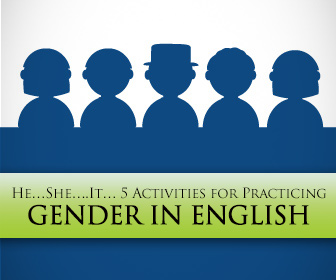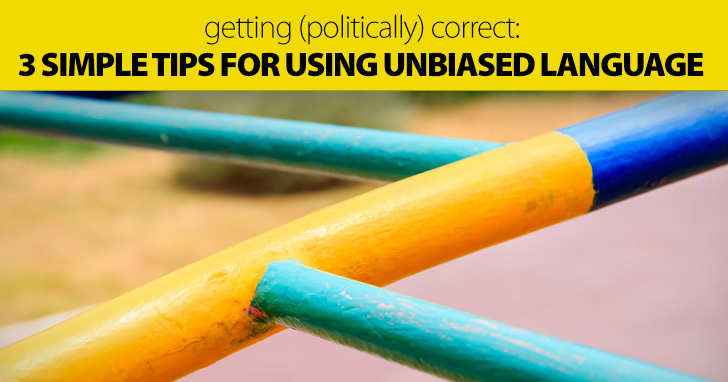He…She….It… 5 Activities for Practicing Gender in English


With just one simple choice of language, speakers can either offend their listeners or endear them to themselves. For some ESL students, choosing the correct (and politically correct) words will be easy, but for others it can be a real challenge. Learning to choose inoffensive words or phrases is possible for your ESL students with a little instruction and a bit of intention. Here are some simple tips you can teach even your beginning ESL studentsbeginning ESL students for making sure they choose the best words possible.

In the past, it was acceptable to use male terms to refer to both female and male members of a group. For example, a person could say that everyone who is coming on the trip should bring his own sleeping bag or they could have a solution for all of mankind. But in today’s society, male specific language to refer to an entire group of people is considered offensive in many circles, and your ESL students will attract the wrong kind of attention if they fall into this old fashioned habit. These days, most male specific terms have a gender neutral version that are acceptable in casual speech where their male specific ones aren’t. Frequently, these words will come up when you are teaching occupations to your ESL students. Encourage them to recognize the gender specific words when other people use them, but encourage them to use the gender neutral ones in their own language. For example, rather than saying something about mankind, say it about human kind. Instead of referring to your waiter or waitress, refer to your server. And don’t say that a mailman delivers the mail but that a mail carrier does. Your role as ESL teacher is to point out the other options your students have for these gender specific words and make sure they use the neutral ones in place of them.
When someone is trying to use gender neutral language, a frequent strategy is to use the expression he/she or his/hers. While that is acceptable, it can get quite bulky in a sentence, and sounds especially strange in spoken English. You can teach your students a better strategy for handling the situation. In casual speech, you will often hear native English speakers use they to refer to a single person of nonspecific gender. This happens all the time in conversations, emails, texts, and other informal writing situations. While it is socially acceptable to do this, it is grammatically incorrect. They is a plural pronoun and should not be used to refer to a singular antecedent. You should make sure that your ESL students do not choose this option for any formal writing. This would include any academic writing or any business related writing as well as public information such as a website. The simple solution to this he/she/they dilemma is to make the pronoun plural, not just for the pronoun but throughout the sentence. A gender biased sentence might look like this: Any person who is learning English should try his best. A better but bulky option is this: Any person who is learning English should try his or her best. You can improve the gender bias and the bulkiness by changing the sentence to this, but it becomes ungrammatical when you do: Any person who is learning English should try their best. This sentence would be okay for informal speech, but not for any formal speech or writing. The best option is to pluralize all forms of the noun in the sentence like this: People who are learning English should try their best. Changing person to people allows your ESL students to use the pronoun their and still have a grammatical sentence without having to resort to the he/she strategy. When you challenge students to use this method, have them double check verb and pronoun agreement in their final piece of writing so as not to let any little mistakes slip past them.
Grammatically speaking, when one or the other is necessary as an adjective in a sentence, choose female or male. Women and men are nouns and should not be used as adjectives in a sentence. While female and male can be used as both an adjective or a noun, they are most frequently used as adjectives. So clearing up the male/men question should be fairly easy, but even when they have the grammar correct, ESL students should be wary about pointing out that a particular group is either male or female. When someone stresses the gender of a group of people, such as female doctors, intentionally or not they are implying that it is unusual or inappropriate for someone of that gender to have that role. The same can also be said of expressions such as male nurses or female members of congress. All of these statements carry negative connotations for the gender that is mentioned. When a person does need to point out a gender specific group, it should only be done when that person would point out both the male and the female groups. For example, a student might talk about the men’s basketball team and the women’s basketball team but not the basketball team and the women’s basketball team. This implies equality between the genders. You should also point out to your students that the words men’s and women’s are used in the possessive. We do not say the men basketball team and the women basketball team.
Do you have other tips for using language that is not gender biased? Share it in the comments section below.